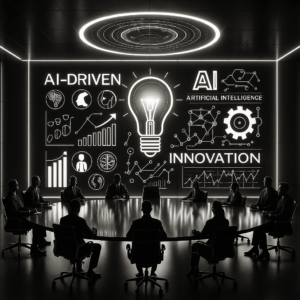Table of Contents
- What Is the Entrepreneurial Mindset?
- Preparing Organizations for the Future
- Five Core Training Modules to Develop Innovative Competencies
- From Failure to Strength: Encouraging a Learning Culture
- Which Teams Benefit the Most from This Training?
- How to Integrate It into Corporate Culture?
- Building the Future from Within
Sustainable growth cannot be achieved merely by doing more of what is already being done. True growth occurs by unlocking employees’ creativity, curiosity, and new ways of thinking. Developing an entrepreneurial culture within an organization is no longer just the choice of visionary companies, it has become a necessity to adapt to changing market conditions, generate innovation, and secure long-term competitive advantage. So, how can this mindset be built across different departments and the organization as a whole? In this article, we explore how to design corporate entrepreneurship training programs that strengthen employee engagement, increase ownership, make innovation a natural reflex, and bring bold ideas to life.
What Is the Entrepreneurial Mindset?
The entrepreneurial mindset is the ability to identify opportunities, assess risks, make decisions in uncertain environments, and implement those decisions strategically. Employees with this mindset approach challenges with a growth perspective, question established assumptions, and are unafraid to try new solutions.
This way of thinking aligns with the principles of entrepreneurial leadership, which involve taking initiative without formal authority, inspiring others to act, and leading change. The goal is not for every employee to start their own venture, but to equip them with the skills to innovate, develop creative solutions to problems, and act in line with the organization’s strategic objectives.
An entrepreneurial mindset also places continuous learning at its core. In organizations that support this mindset, cross-team collaboration strengthens, innovations are implemented more quickly, and the capacity to adapt to change increases.
Preparing Organizations for the Future
Organizations operate in an ecosystem rapidly shaped by technological advancements, global competition, and shifting customer expectations. A highly profitable business model today may lose its relevance tomorrow. For this reason, renewal and innovation have become the responsibility of the entire organization, not just the R&D department.
Forward-thinking companies invest in entrepreneurship training programs to enhance employees’ resilience, encourage diverse perspectives, and strengthen in-house innovation capacity. These programs give employees the chance to learn from the startup ecosystem, test ideas quickly, and gain lessons from mistakes.
From redesigning a process to launching a new product or service idea, this approach initiates internal transformation. As a result, an innovative workforce emerges, one that can move forward even in uncertainty, seize opportunities swiftly, and contribute to the organization’s growth.
Five Core Training Modules to Develop Innovative Competencies
Effective corporate entrepreneurship training should combine theory with practice, giving participants both knowledge and experience. A successful program should include the following five core areas:
- Problem Solving and Opportunity Analysis
Participants learn to analyze problems and identify hidden opportunities using systematic innovation methods. This stage strengthens both analytical thinking and strategic foresight skills. - Rapid Prototyping and MVP Development
Applying design thinking principles, solutions tailored to real user needs are developed. The minimum viable product (MVP) approach allows ideas to be tested at low cost, reducing risks and accelerating learning. - Customer-Centric Innovation
Participants gain the ability to develop solutions centered around customer needs. Removing boundaries between departments leads to stronger innovations born from the fusion of ideas from different disciplines. - Business Model Innovation and Revenue Design
Teams learn how to transform ideas into sustainable, economically viable business models. This section includes case studies covering investor perspectives, market analysis, and competitive strategies. - Intrapreneurial Project Leadership and Agility
Employees develop the ability to initiate, manage, and lead change in internal projects. Collaboration in cross-functional teams and agile working principles are central to this process.

From Failure to Strength: Encouraging a Learning Culture
In innovation, failure should not be seen as defeat but as an opportunity to learn. One of the most valuable skills is the ability to quickly extract lessons from failure and take stronger steps in the next attempt. To cultivate this culture, experimentation must be normalized, and learning should be rewarded.
Example Practice: “What Did We Learn?” Sessions
Regular meetings can be organized where teams discuss the outcomes of projects and what could be done differently in the future. This approach increases transparency, encourages constructive feedback, and fosters an environment that strengthens creativity and collaboration.
Innovation labs, prototyping workshops, and shared workspaces provide strong physical and digital platforms to embed this culture.
Which Teams Benefit the Most from This Training?
Innovation is not just the responsibility of the R&D department, it must be spread throughout the organization. This training delivers high value especially to the following departments:
• Product and service design
• Sales and marketing
• Operations and process development
• Human resources and talent management
• Strategy and transformation offices
Cross-functional teams combine knowledge and experience from different disciplines, moving beyond silo structures. When these teams work with a shared innovation language, the results are far more impactful than those produced by single-department initiatives.
Embedding an innovative mindset across all departments creates a chain reaction, enabling every team to seize opportunities more quickly and respond to changing conditions with agility and creativity.
How to Integrate It into Corporate Culture?
The entrepreneurial mindset cannot be instilled through a single workshop; making this approach permanent requires continuous and multi-faceted reinforcement. The integration process should be strategic, measurable, and designed to permeate the entire organization.
• Leadership Alignment: Senior management should not only support the entrepreneurial mindset but actively practice it. Leaders serving as role models are the most powerful influence in employees adopting this approach. Senior management should prioritize innovation culture in strategic decisions and use this language in daily communication.
• Visible Success Stories: Corporate communication channels should regularly feature success stories from innovation projects. Sharing small but meaningful wins motivates other teams. These stories should describe not only the end result but also the process, the obstacles overcome, and the lessons learned.
• Team Learning Cycles: A learning culture is essential for sustainable innovation. Short, focused, and regular training sessions; mentoring meetings; and post-project review sessions should be used to reinforce learning. Internal trainers or “innovation ambassadors” can be designated to institutionalize this cycle.
• Support Systems: Innovation labs, idea development platforms, and mentoring programs should be established to provide tangible mechanisms for employees to bring their ideas to life. Access to these systems should be easy, with minimal bureaucracy.
• Recognition and Incentive Mechanisms: Employees who implement innovative ideas, take risks, and think differently should be rewarded both financially and non-financially. Incentive systems should go beyond short-term motivation to create long-term commitment.
• Integration into Processes: The entrepreneurial mindset should be embedded not only in special projects but also in daily business processes. Including innovation criteria in project planning, goal setting, and performance evaluation systems ensures that this culture becomes permanent.
• Cross-Functional Collaboration: Cross-departmental teams enable ideas to be evaluated from multiple perspectives. Supporting such structures increases knowledge sharing across the organization and strengthens the common innovation language.
All these steps help integrate the entrepreneurial mindset into the organization’s DNA. The goal is not only to apply what is learned during training but also to make this approach one of the company’s natural reflexes over time.

Building the Future from Within
Entrepreneurship is not only about starting a new company, it is about leading change. Organizations that invest in developing an entrepreneurial mindset build a culture of agility, accountability, and sustainable innovation. Employees learn to think like entrepreneurs, act like leaders, and collaborate across teams.
Unlocking this potential paves the way not only for innovative ideas but also for robust systems, aligned teams, and cross-functional collaboration. This transforms organizations from the inside out, creating structures that can adapt quickly to change and seize future opportunities today.




